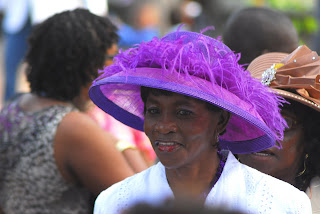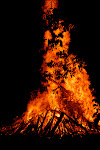Looking for Brown Rum
My mission, having decided to accept it, was to track down six men - to seek them out, get them to perform a simple task and deliver the product of the exercise to my client. There was a deadline…and a reward.
The client meeting was held on a Friday morning and the deadline for delivery was the following Monday, for a Friday press appearance. The campaign, for an alcoholic beverage, was to associate the bottle of brown spirit with the pleasure men derived from bonding over a domino game, or just chillin’.
In case you are wondering what happens when an advertising agency misses a press deadline, I recall a blank rectangular space in one of our daily newspapers, with a line of copy that read, “This space reserved for X & Y Advertising.” They never missed another deadline.
The client had looked through my stock library and discovered two images that fit the requirement. One shot was of a group of men playing dominoes under an ackee tree. The other was of two men reclining on the jetty at Oistin. I had to find the subjects, get them to sign releases, and pay them their fee… simple, except that the photographs had been taken some 10 -15 years earlier.
I decided to tackle the domino group first and set off for Mt Brevitor, St Peter. The ackee tree was my point of reference. Mt Brevitor is one of those more remote corners of Barbados not far from another similar area with a more familiar name – Lonesome Hill. It is a village of about 20 houses, lying to the west and slightly south of Farley Hill.
The Mt Brevitor road meanders gradually uphill from its junction with highway 2A and as I approached the village, I saw the ackee tree standing like a sentinel, spreading its shade like a giant umbrella, over the houses on either side. I approached the house nearest the tree and knocked.
A man appeared and I showed him the photograph, enquiring if he knew where I could find the young men playing dominoes. “Young men? Dese en young men nuh more, skipper! All dese is hardback men now. Dis fella live up de road dey… de brown house above the almond tree pun de leff.” He then fell silent as he twisted the photo to get a better view. “Oh *#~*! *#~*!” He exclaimed. “Dis is Poochin… he in jail!
Dis fella here, he duz work at Banks… and diswun here… dat backing… I en know who he is. Mussee from outside.”
I thanked him, and armed with the names, went first to the house in the district to make arrangements with Subject One. He wasn’t at home, so I agreed to return next day. My weekend was now shot.
Subjects Two and Four ruled themselves out of remuneration, one by virtue of residing at Her Majesty’s pleasure and the other rendered unrecognizable by having his back to the camera. The Banks’ employee was next. This meant a quick dash from Mt Brevitor to Banks Brewery in Wildey, to get there before closing time on Friday afternoon. He was an easy find and that concluded the Mt Brevitor bunch.
I designated Sunday the Oistin-search-day for the two men in the other photo.
I arrived at the Oistin fish market to a lazy scene of morning-after-recovery. A random sprinkling of men, spread like strategically placed items on an obstacle course, greeted me. I suspected that most of them had not seen home since the day before. I selected two who were fairly close together, as a starting point.
“Morning sir… I need your help in finding the chap in this photo”. One of the two in the photo was looking away from the camera but the other’s face was in full view.
“Who you is?”
I explained my mission and he appeared satisfied.
“Dis look like it could be Brown Rum, but I en sure”. He now turned to his colleague who was sprawled uncomfortably across two chairs, apparently in deep sleep.
“Joe… dis is Brown Rum?” he asked, waving the print towards Joe as if he were wide-awake. No answer from Joe. The interrogator then bent over Joe’s face, his mouth barely inches from Joe’s ear, and bellowed, YOOOU!!
Joe shot bolt upright as if a thunderbolt had hit him.
“Huhh??... Wuhh??”
“Dis is Brown Rum?” he repeated.
“I gine an wash my face”, was Joe’s response as he rose unsteadily and headed for the bathroom. I was a little bewildered, but I guess so was Joe.
He soon returned, took a look at the photograph and mumbled, “Dah’s Brown Rum”
“Where can I find him?”
“Guhdown by St Lawrence Gap, in de Top Rock corner and check de house… one from de shop at de corner and ask fuh Brown Rum.”
Thanking them, I headed to St Lawrence Gap, Top Rock exit and the house ‘one from de shop at de corner’. I knocked and a man’s head poked through the widow.
“Yeah?”
“Good morning, I’m looking for Brown Rum”.
“Brown Rum ain’ here. Diz Sundee morning. Brown Rum gone colleckin money, man. He’s a fisherman and he’s collect ‘e money pun a Sundee. You goaw check he bout 8 o’clock tonight, in a shop in Sargeant Village, where de got Karaoke”.
“Where in Sargeant’s Village?”
“Lil before de corner by Sheraton, pun the left, cross de road from de bus stop, duh goaw blue shop. Check dey… I tink it dey”.
8:15 Sunday night. I park opposite a blue two-door shop in Sargeant’s village. The emanating sounds suggest a weekend’s last hurrah. Smoke from a barbecue grill in the yard floated up into the trees. The aroma invited me in. A confident but discordant voice struggled to hold a melody in check, suggesting that I should perhaps wait until the fight was over before entering.
Too late. The momentum from hurriedly crossing Highway 6 propelled me through the door and into a band of merry men. Greetings all round. I cranked my voice up: “I looking for a fella name Brown Rum”
“Man, come and fire one!”
“I would love to… but I really got to find Brown Rum first.”
“Alright… but Brown Rum ain’ here. Guhup to de next gap pun yuh right, when you turn in, drive lil ways and yuh gun see a lil track pun yuh left. Doan mine how it look, trust me, turn trouit and drive till yuh cahn drive nuh more. Duhgun got a shop in front yuh. Guh dey and ask fuh Brown Rum. And when yuh done, come back and fire one wid we”
My headlights illuminated a grassy track that appeared not to have seen any recent vehicular traffic. I cautiously picked my way through grass that could have obscured a toddler. The lights picked out a squarish wooden structure about 50 yards ahead, with a silhouetted figure leaning against the door frame. Behind him was a pool table with a few figures engaged in a game. I drove a little further, but realising I might have to reverse to get out, decided to walk the rest.
The scent of ganja drifted towards me. The demeanour of the guy in the door had not changed and as I approached he stared at me intently. “Good evening”, I said as I passed him. No answer. “Is the owner here?” I enquired. He half turned and pointed to a man behind the bar. “Ralph, man want you”.
Once again I explained my mission.
“Brown Rum due here but he ain’ get here yet. Holon, I gun call ‘e. He dialled a number, had a brief conversation then said, “Okay, guh back out to de gap and guh down lil ways further and look pun yuh right, right up inside a lil narrow track yuh gine see a lil shop down inside dey. Brown Rum dey”.
The ‘lil track’ was so ‘lil’ that it took driving through the area twice to find it. Two young ladies having a hair plaiting session by the roadside regarded me curiously as I cruised by. I approached once again on foot and the aroma of pan-fried flying fish wafted by me on the breeze. I stepped into a space big enough for a table, four chairs, and a few stools. Three men were seated at the table clutching various bottles of alcoholic beverages and looking as though they had reached the end of a 12-hour drinking marathon. Behind a counter was the source of the nose alert. A business-like, bespectacled lady was doing the honours. Except for the sizzling in the pan, there was quiet.
“Good evening. I’m looking for Brown Rum.”
“Who want ‘e?”
I gave my name and my mission.
“I is Brown Rum”, said the man in the centre.
“Would you please have a look at this picture and confirm that this is a photo of you?
He took the photograph, studied it for a moment then looked up at me and said, “I doan know”.
“You don’t know??... How come?”
“Skipper, I en got my glasses, so I cahn see!”
I was little less than amused. It had taken me virtually a whole day and five encounters later to find this man and now he couldn’t see the photo because he didn’t have his glasses!!
He must have at least been able to see well enough to spot the look of exasperation on my face, so he passed the photo to the chap on his left and asked, “Dah’s me?” There was a mumbled exchange but no conclusion.
“You would got to come by me in de morning early when I got my glasses and I will tell yuh.”
So said, so done. 7:00 am found me knocking at the house, ‘one from de shop at de corner’. Brown Rum appeared, retrieved his glasses, looked at the photograph and confirmed it was he. He then duly signed the release and collected his payment, and I sent the signed releases to the client. My mission was accomplished. The campaign began its three-month rotation from the Friday of that week.
About two weeks later I got a phone call. The caller confirmed that he was speaking with ‘the photographer’, then said, “You gotta picture of me in the paper advertising rum and I en know nutten bout it!”
“Excuse me?”
He repeated.
“Sir, I’m sorry, but I made arrangements with a man from St Lawrence who goes by the name of Brown Rum, to use that photograph and I paid him for it.”
“Well dah’s me in de picture and I want money”.
I figured I was dreaming, so I stood up to check. No, I was awake!
“Sir, could you come to my office so I can meet you and discuss this?”
He turned up at my office two days later and while there was a vague resemblance I was certain this was not the man in the picture.
“Is this you?” I asked, showing him a copy of the photograph. He looked at it, blinked a few times, then said, “yuh see, I din really see the advertisement but uh fren a mine from St Peter call me and tell me he see my picture in de paper, advertising rum.
“Aha! A friend called you. Well sir, I think you need to tell your friend he made a mistake and sent you to claim money under false pretences – which of course is an offence under the law!”
“Okay sir, I see. I think ‘e mek a mistake”.
“I think so too. Thank you for coming”
As he walked away, I thought he would have had a better case if he had claimed to be the domino player who was backing the camera, under the ackee tree at Mt Brevitor.
Maybe he was!
.

































